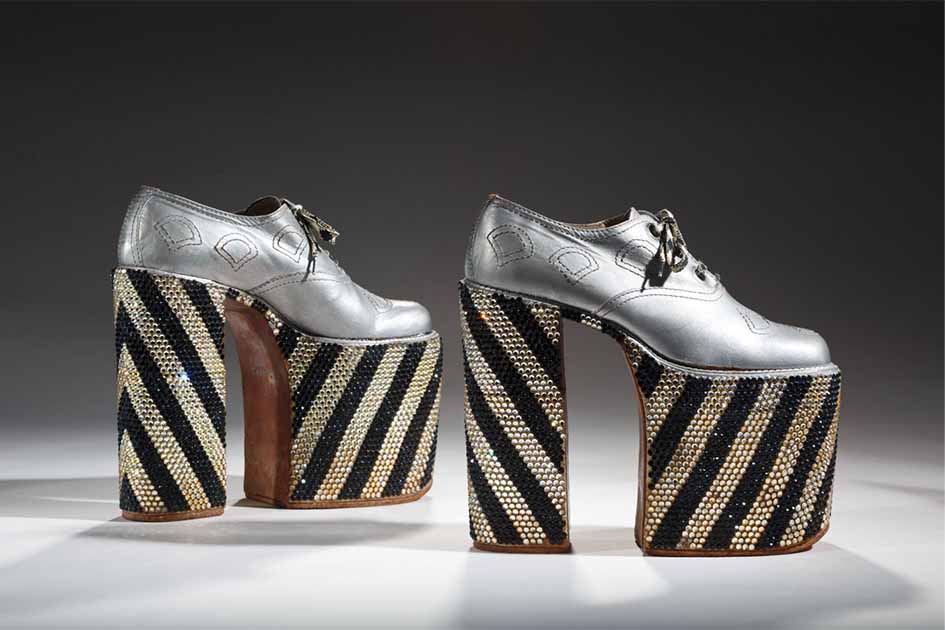Excerpt from an interview with Elizabeth Semmelhack by Alicia McDermott
Step into the captivating world of shoes with Elizabeth Semmelhack, the Director and Senior Curator of the Bata Shoe Museum. Elizabeth’s work focuses on the intersections of fashion, culture, and economics with a particular interest in the history of footwear. Since starting in 2000, she has curated 28 exhibitions, written 11 books and catalogues, and over 30 chapters and articles. Her most recent exhibitions are Obsessed: How Shoes Became Objects of Desire and Future Now: Virtual Sneakers to Cutting-Edge Kicks (2022), and her most recent publications are Future Now: Virtual Sneakers to Cutting-Edge Kicks (Rizzoli: 2022), The World at Your Feet: The Bata Shoe Museum Collection (Rizzoli: 2020), and Collab: Sneakers x Culture (Rizzoli: 2019).
AM: Tell us a bit about what we can see during a visit to the Bata Shoe Museum.
ES: The Bata Shoe Museum has close to 15,000 artifacts in its collection and the exhibitions on view draw on this collection. Because the museum has four galleries, one permanent and three temporary, artifacts are constantly being changed. This means that there is always something new to see when you visit the museum.
Our largest gallery houses our permanent exhibition, All About Shoes. It introduces people to why shoes are interesting and touches on their wide-ranging uses from protection and function to status and fashion. The themes in this exhibition stay the same but the artifacts are frequently rotated. The other three galleries house temporary exhibitions. This summer, 2023, the three exhibitions on view are Obsessed: How Shoes Became Objects of Desire, Future Now: Virtual Sneakers to Cutting-Edge Kicks, and In Bloom: Flowers and Footwear.

Cherry blossom Manchu platforms. Credit: Bata Shoe Museum
AM: How have cultural and societal factors influenced the design and style of shoes throughout history?
ES: Arguably every shoe ever created has been influenced by cultural and societal factors. One example is shoes with heels. Heels were, I have argued, originally created as an equestrian tool developed in relationship to the stirrup. I have traced them as far back to 10th century Persia, but I believe they date back even further and may have even been invented elsewhere in Western Asia. Northern European men began to have heels added to their riding boots around the turn of the 17th century when England, Holland, and Persia became interested in creating trade and political alliances. One of the things that Persia brought to the table was a significant mounted military, all of whom wore heels.
European women adopted the high heel shortly after men as part of a fashion trend that invited women to borrow from the male wardrobe. Heels were worn by women in the effort to masculinize their appearance.

Persian riding shoes. Credit: Bata Shoe Museum, photo by Ron Wood
AM: Are there any unique or unusual shoes in the museum's collection that tell fascinating stories about the wearer or the era in which they were made?
ES: Lancashire clogs are not unusual, but they are one of the types of footwear that often stumps many people who think that they might date back to Early Modern Europe. Instead, Lancashire clogs were worn in the 19th and well into the 20th century as a form of working-class footwear worn throughout Great Britain but most commonly in the industrial towns in the north.
This style of footwear was commonly worn by workers in the northern textile factories and led to the creation of Lancashire clog dancing as women working in the factories repeated the beat of the machines they were working with. These steps were then incorporated into dances. There are many extant examples of children’s Lancashire clogs in North America, and it seems that some may have been kept or purchased as mementos of home by people who immigrated.

Red Lancashire clogs. (Jackhyne / CC BY-SA 3.0)
AM: Are there any shoes in the museum that have become iconic or are associated with notable individuals or historical events?
ES: We have a pair of Elton John’s high platform shoes from the 1970s. They are probably the most famous shoes in our collection. He cheekily stated that this pair was too plain and that he only wore them shopping, but we have seen photos of him wearing them on stage. They not only reflect Sir John and his ostentatious style in the 1970s, but they also reflect the much larger trend in men’s fashion that encouraged men to wear heels again. These shoes are a fan favorite but unfortunately they are not always on view as we need to preserve them for future generations.

Elton John’s platforms. Credit: Bata Shoe Museum, photo by Ron Wood
AM: Looking ahead, how do you see the future of shoe design and innovation unfolding?
ES: I think there are many interesting innovations currently being worked on in the footwear space that will impact what we wear in the future. Innovative new techniques, groundbreaking materials, and growing concerns about sustainability and inclusion are propelling future-looking designers to create incredible new forms of footwear. These include shoes made using mushroom leather, auto-lacing sneakers, and footwear designed to be worn on avatars in the metaverse.
Get the whole story: read the full interview in the July - August 2023 issue of Ancient Origins Magazine. Get it here!
Featured Image: 17th century Italian shoe. Source: Credit: Bata Shoe Museum, photo by Ron Wood




